Contents
Preface
Chapter 1. Introduction to Probability Theory
1.1 Introduction
1.2 Sample Space and Events
1.3 Probabilities Defined on Events
1.4 Conditional Probabilities
1.5 Independent Events
1.6 Bayes’ Formula
Exercises
References
Chapter 2. Random Variables
2.1 Random Variables
2.2 Discrete Random Variables
2.2.1 The Bernoulli Random Variable
2.2.2 The Binomial Random Variable
2.2.3 The Geometric Random Variable
2.2.4 The Poisson Random Variable
2.3 Continuous Random Variables
2.3.1 The Uniform Random Variable
2.3.2 Exponential Random Variables
2.3.3 Gamma Random Variables
2.3.4 Normal Random Variables
2.4 Expectation of a Random Variable
2.4.1 The Discrete Case
2.4.2 The Continuous Case
2.4.3 Expectation of a Function of a Random Variable
2.5 Jointly Distributed Random Variables
2.5.1 Joint Distribution Functions
2.5.2 Independent Random Variables
2.5.3 Covariance and Variance of Sums of Random Variables
2.5.4 Joint Probability Distribution of Functions of Random Variables
2.6 Moment Generating Functions
2.6.1 The Joint Distribution of the Sample Mean and Sample Variance from a Normal Population
2.7 The Distribution of the Number of Events that Occur
2.8 Limit Theorems
2.9 Stochastic Processes
Exercises
References
Chapter 3. Conditional Probability and Conditional Expectation
3.1 Introduction
3.2 The Discrete Case
3.3 The Continuous Case
3.4 Computing Expectations by Conditioning
3.4.1 Computing Variances by Conditioning
3.5 Computing Probabilities by Conditioning
3.6 Some Applications
3.6.1 A List Model
3.6.2 A Random Graph
3.6.3 Uniform Priors, Polya’s Urn Model, and Bose–Einstein Statistics
3.6.4 Mean Time for Patterns
3.6.5 The k-Record Values of Discrete Random Variables
3.6.6 Left Skip Free Random Walks
3.7 An Identity for Compound Random Variables
3.7.1 Poisson Compounding Distribution
3.7.2 Binomial Compounding Distribution
3.7.3 A Compounding Distribution Related to the Negative Binomial
Exercises
Chapter 4. Markov Chains
4.1 Introduction
4.2 Chapman–Kolmogorov Equations
4.3 Classification of States
4.4 Limiting Probabilities
4.5 Some Applications
4.5.1 The Gambler’s Ruin Problem
4.5.2 A Model for Algorithmic Efficiency
4.5.3 Using a Random Walk to Analyze a Probabilistic Algorithm for the Satisfiability Problem
4.6 Mean Time Spent in Transient States
4.7 Branching Processes
4.8 Time Reversible Markov Chains
4.9 Markov Chain Monte Carlo Methods
4.10 Markov Decision Processes
4.11 Hidden Markov Chains
4.11.1 Predicting the States
Exercises
References
Chapter 5. The Exponential Distribution and the Poisson Process
5.1 Introduction
5.2 The Exponential Distribution
5.2.1 Definition
5.2.2 Properties of the Exponential Distribution
5.2.3 Further Properties of the Exponential Distribution
5.2.4 Convolutions of Exponential Random Variables
5.3 The Poisson Process
5.3.1 Counting Processes
5.3.2 Definition of the Poisson Process
5.3.3 Interarrival and Waiting Time Distributions
5.3.4 Further Properties of Poisson Processes
5.3.5 Conditional Distribution of the Arrival Times
5.3.6 Estimating Software Reliability
5.4 Generalizations of the Poisson Process
5.4.1 Nonhomogeneous Poisson Process
5.4.2 Compound Poisson Process
5.4.3 Conditional or Mixed Poisson Processes
Exercises
References
Chapter 6. Continuous-Time Markov Chains
6.1 Introduction
6.2 Continuous-Time Markov Chains
6.3 Birth and Death Processes
6.4 The Transition Probability Function Pij(t)
6.5 Limiting Probabilities
6.6 Time Reversibility
6.7 Uniformization
6.8 Computing the Transition Probabilities
Exercises
References
Chapter 7. Renewal Theory and Its Applications
7.1 Introduction
7.2 Distribution of N(t)
7.3 Limit Theorems and Their Applications
7.4 Renewal Reward Processes
7.5 Regenerative Processes
7.5.1 Alternating Renewal Processes
7.6 Semi-Markov Processes
7.7 The Inspection Paradox
7.8 Computing the Renewal Function
7.9 Applications to Patterns
7.9.1 Patterns of Discrete Random Variables
7.9.2 The Expected Time to a Maximal Run of Distinct Values
7.9.3 Increasing Runs of Continuous Random Variables
7.10 The Insurance Ruin Problem
Exercises
References
Chapter 8. Queueing Theory
8.1 Introduction
8.2 Preliminaries
8.2.1 Cost Equations
8.2.2 Steady-State Probabilities
8.3 Exponential Models
8.3.1 A Single-Server Exponential Queueing System
8.3.2 A Single-Server Exponential Queueing System Having Finite Capacity
8.3.3 Birth and Death Queueing Models
8.3.4 A Shoe Shine Shop
8.3.5 A Queueing System with Bulk Service
8.4 Network of Queues
8.4.1 Open Systems
8.4.2 Closed Systems
8.5 The System M/G/1
8.5.1 Preliminaries: Work and Another Cost Identity
8.5.2 Application of Work to M/G/1
8.5.3 Busy Periods
8.6 Variations on the M/G/1
8.6.1 The M/G/1 with Random-Sized Batch Arrivals
8.6.2 Priority Queues
8.6.3 An M/G/1 Optimization Example
8.6.4 The M/G/1 Queue with Server Breakdown
8.7 The Model G/M/1
8.7.1 The G/M/1 Busy and Idle Periods
8.8 A Finite Source Model
8.9 Multiserver Queues
8.9.1 Erlang’s Loss System
8.9.2 The M/M/k Queue
8.9.3 The G/M/k Queue
8.9.4 The M/G/k Queue
Exercises
References
Chapter 9. Reliability Theory
9.1 Introduction
9.2 Structure Functions
9.2.1 Minimal Path and Minimal Cut Sets
9.3 Reliability of Systems of Independent Components
9.4 Bounds on the Reliability Function
9.4.1 Method of Inclusion and Exclusion
9.4.2 Second Method for Obtaining Bounds on r(p)
9.5 System Life as a Function of Component Lives
9.6 Expected System Lifetime
9.6.1 An Upper Bound on the Expected Life of a Parallel System
9.7 Systems with Repair
9.7.1 A Series Model with Suspended Animation
Exercises
References
Chapter 10. Brownian Motion and Stationary Processes
10.1 Brownian Motion
10.2 Hitting Times, Maximum Variable, and the Gambler’s Ruin Problem
10.3 Variations on Brownian Motion
10.3.1 Brownian Motion with Drift
10.3.2 Geometric Brownian Motion
10.4 Pricing Stock Options
10.4.1 An Example in Options Pricing
10.4.2 The Arbitrage Theorem
10.4.3 The Black-Scholes Option Pricing Formula
10.5 White Noise
10.6 Gaussian Processes
10.7 Stationary and Weakly Stationary Processes
10.8 Harmonic Analysis of Weakly Stationary Processes
Exercises
References
Chapter 11. Simulation
11.1 Introduction
11.2 General Techniques for Simulating Continuous Random Variables
11.2.1 The Inverse Transformation Method
11.2.2 The Rejection Method
11.2.3 The Hazard Rate Method
11.3 Special Techniques for Simulating Continuous Random Variables
11.3.1 The Normal Distribution
11.3.2 The Gamma Distribution
11.3.3 The Chi-Squared Distribution
11.3.4 The Beta (n, m) Distribution
11.3.5 The Exponential Distribution—The Von Neumann Algorithm
11.4 Simulating from Discrete Distributions
11.4.1 The Alias Method
11.5 Stochastic Processes
11.5.1 Simulating a Nonhomogeneous Poisson Process
11.5.2 Simulating a Two-Dimensional Poisson Process
11.6 Variance Reduction Techniques
11.6.1 Use of Antithetic Variables
11.6.2 Variance Reduction by Conditioning
11.6.3 Control Variates
11.6.4 Importance Sampling
11.7 Determining the Number of Runs
11.8 Generating from the Stationary Distribution of a Markov Chain
11.8.1 Coupling from the Past
11.8.2 Another Approach
Exercises
References
Appendix: Solutions to Starred Exercises
Index
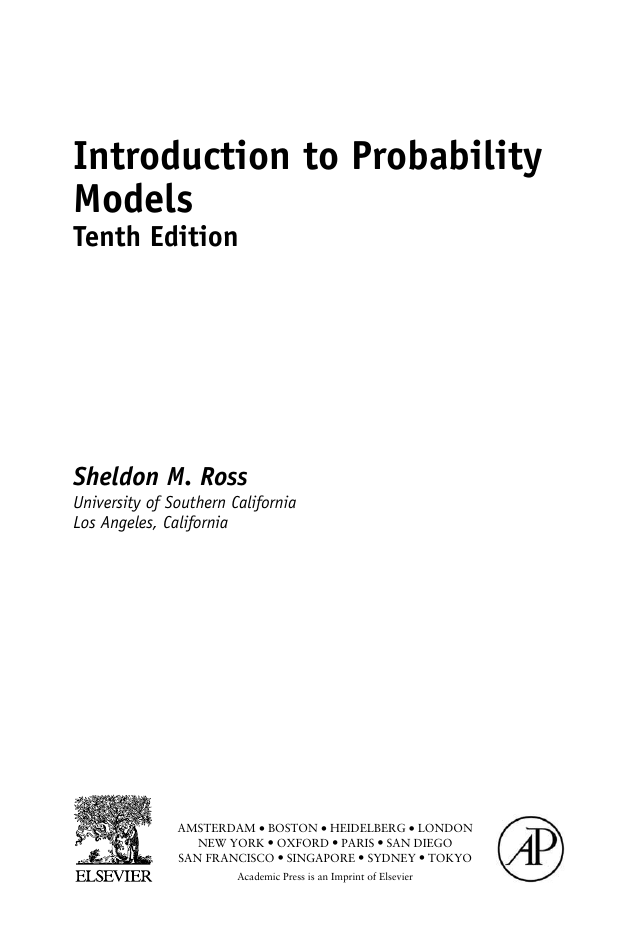
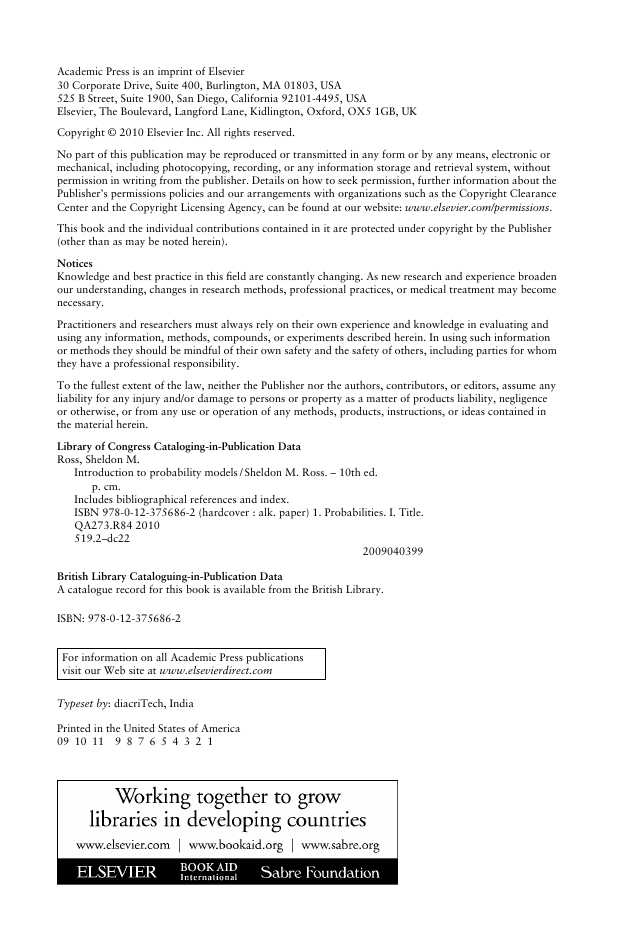
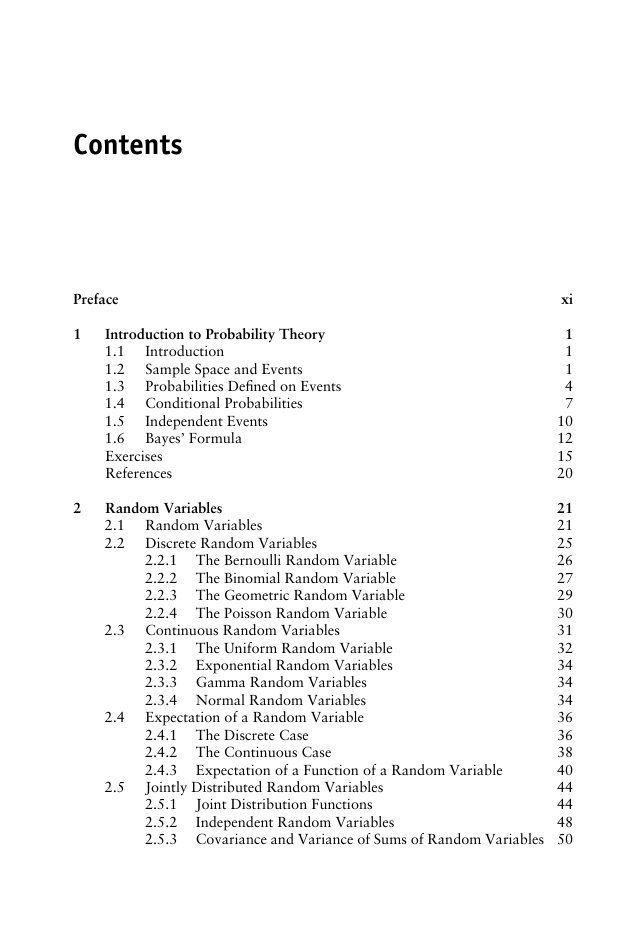

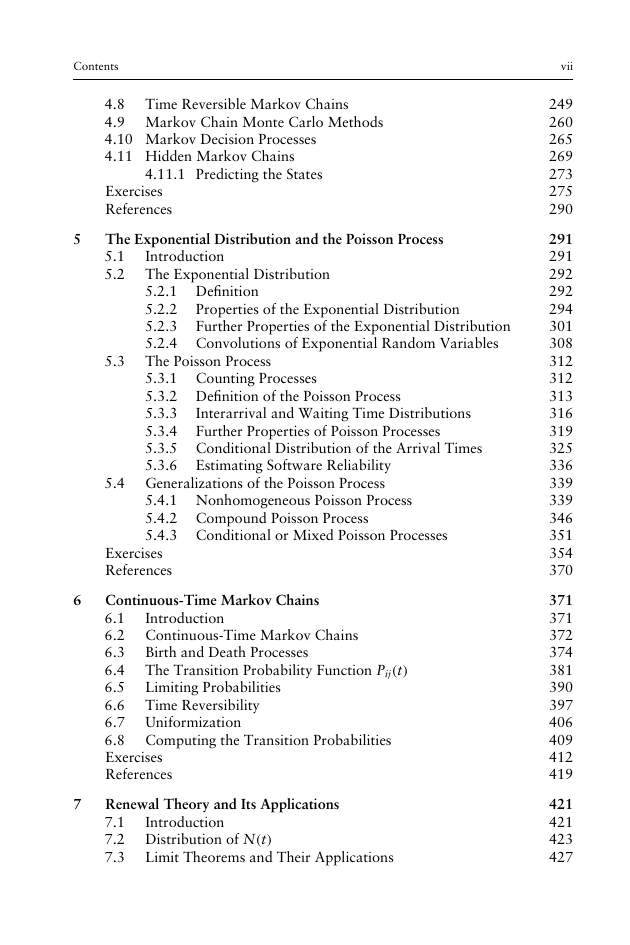
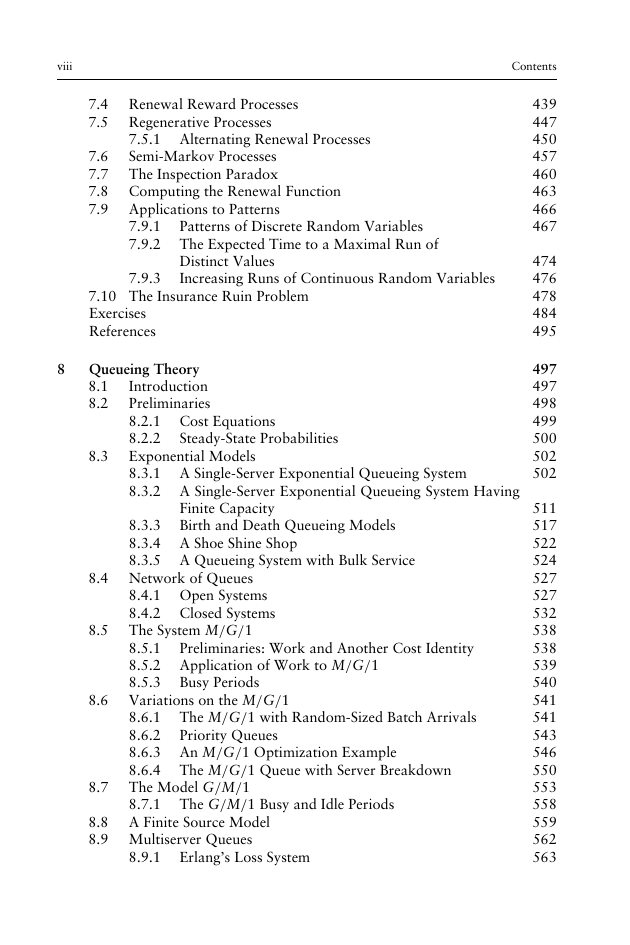
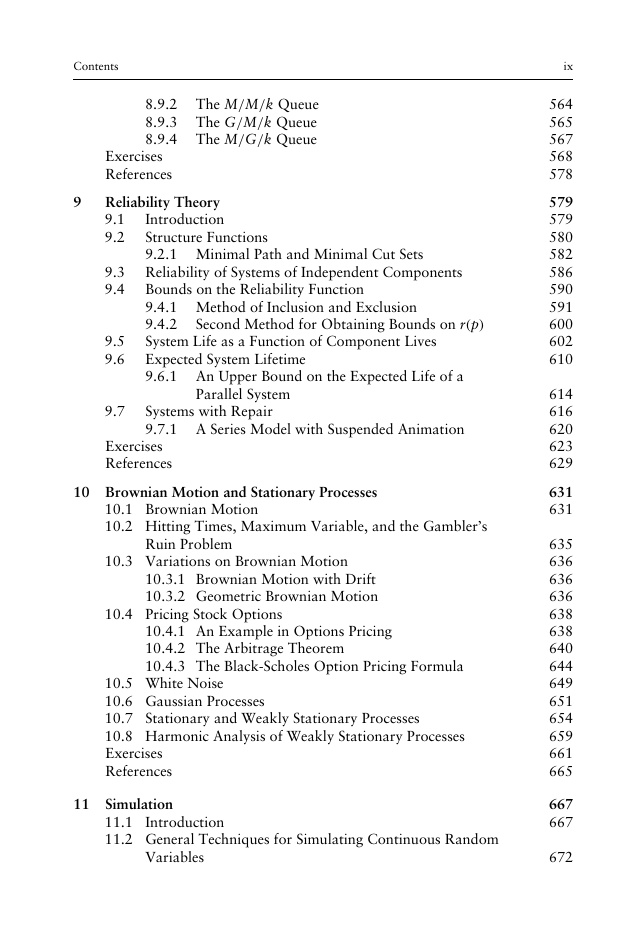
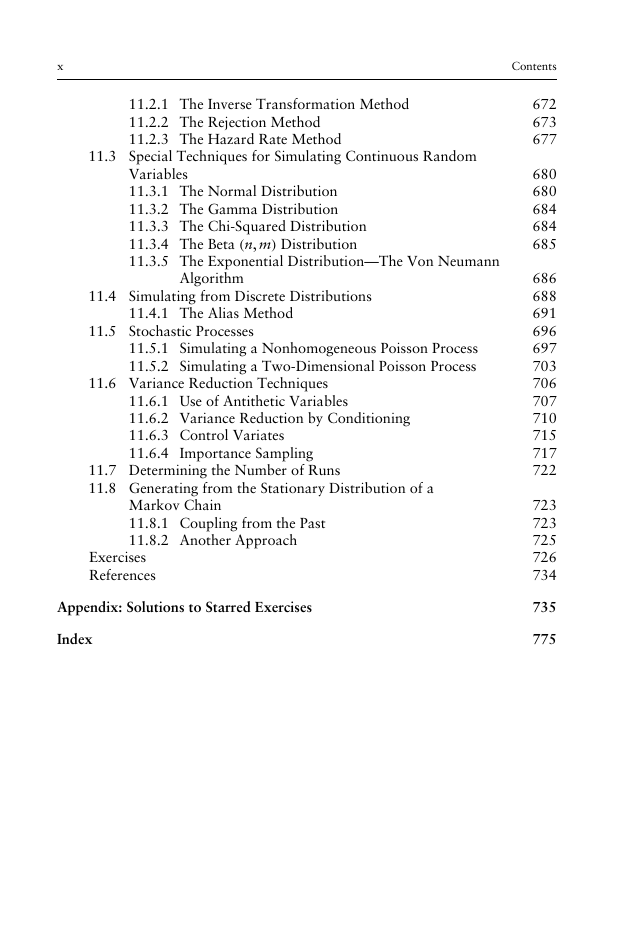








 2023年江西萍乡中考道德与法治真题及答案.doc
2023年江西萍乡中考道德与法治真题及答案.doc 2012年重庆南川中考生物真题及答案.doc
2012年重庆南川中考生物真题及答案.doc 2013年江西师范大学地理学综合及文艺理论基础考研真题.doc
2013年江西师范大学地理学综合及文艺理论基础考研真题.doc 2020年四川甘孜小升初语文真题及答案I卷.doc
2020年四川甘孜小升初语文真题及答案I卷.doc 2020年注册岩土工程师专业基础考试真题及答案.doc
2020年注册岩土工程师专业基础考试真题及答案.doc 2023-2024学年福建省厦门市九年级上学期数学月考试题及答案.doc
2023-2024学年福建省厦门市九年级上学期数学月考试题及答案.doc 2021-2022学年辽宁省沈阳市大东区九年级上学期语文期末试题及答案.doc
2021-2022学年辽宁省沈阳市大东区九年级上学期语文期末试题及答案.doc 2022-2023学年北京东城区初三第一学期物理期末试卷及答案.doc
2022-2023学年北京东城区初三第一学期物理期末试卷及答案.doc 2018上半年江西教师资格初中地理学科知识与教学能力真题及答案.doc
2018上半年江西教师资格初中地理学科知识与教学能力真题及答案.doc 2012年河北国家公务员申论考试真题及答案-省级.doc
2012年河北国家公务员申论考试真题及答案-省级.doc 2020-2021学年江苏省扬州市江都区邵樊片九年级上学期数学第一次质量检测试题及答案.doc
2020-2021学年江苏省扬州市江都区邵樊片九年级上学期数学第一次质量检测试题及答案.doc 2022下半年黑龙江教师资格证中学综合素质真题及答案.doc
2022下半年黑龙江教师资格证中学综合素质真题及答案.doc